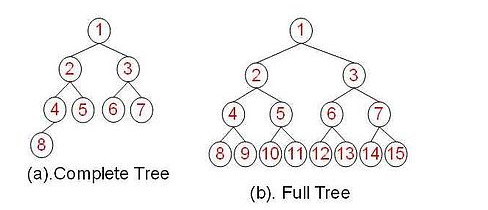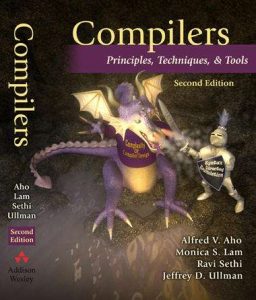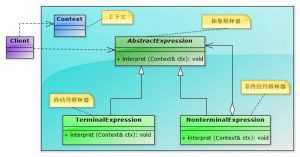堆的定义
堆其实就是一棵完全二叉树(若设二叉树的深度为h,除第 h 层外,其它各层 (1~h-1) 的结点数都达到最大个数,第 h 层所有的结点都连续集中在最左边),定义为:具有n个元素的序列(h1,h2,...hn),当且仅当满足(hi>=h2i,hi>=h2i+1)或(hi<=h2i,hi<=2i+1) (i=1,2,...,n/2)时称之为堆。
大顶堆
堆顶元素(即第一个元素)为最大项,并且(hi>=h2i,hi>=h2i+1),通俗地说父节点比子节点大。
小顶堆
堆顶元素为最小项,并且(hi<=h2i,hi<=2i+1),父节点比子节点小。
堆的性质
当前节点的序号为index,其左右两个自节点的序号为index*2和index*2+1,其父节点的序号为int(index/2);
满二叉树
完全二叉树

完全二叉树的性质
- 具有n个节点的完全二叉树的深度为 k=log2n 。
- 【满二叉树】i层的节点数目为:2i
- 【满二叉树】节点总数和深度的关系:n=∑ki=02i=2k+1−1
- 【完全二叉树】最后一层的节点数为:n−(2k−1)=n+1−2k (因为除最后一层外,为【满二叉树】)
- 【完全二叉树】左子树的节点数为(总节点为n):l(n)={n−2k−1,2k−1,n+1−2k≤2k−1因为最后一层全部都在左子树,右子树为【满二叉树】高度为 k-2n+1−2k>2k−1因为左子树为满二叉树,高度为k-1
- 【完全二叉树】右子树: r(n)=n−l(n)
完全二叉树层次遍历转后序遍历(不构造树)
从1开始
|
1 2 3 4 5 6 |
void toPost(int index){ if(index > n)return; toPost(index * 2); toPost(index * 2 + 1); printf("%d%s", tree[index], index == 1?"\n":" "); } |
PAT 甲级 1147 Heaps (30 分)
In computer science, a heap is a specialized tree-based data structure that satisfies the heap property: if P is a parent node of C, then the key (the value) of P is either greater than or equal to (in a max heap) or less than or equal to (in a min heap) the key of C. A common implementation of a heap is the binary heap, in which the tree is a complete binary tree. (Quoted from Wikipedia at https://en.wikipedia.org/wiki/Heap_(data_structure))
Your job is to tell if a given complete binary tree is a heap.
Input Specification
Each input file contains one test case. For each case, the first line gives two positive integers: M ( 100), the number of trees to be tested; and N (1 N 1,000), the number of keys in each tree, respectively. Then M lines follow, each contains N distinct integer keys (all in the range of int), which gives the level order traversal sequence of a complete binary tree.
Output Specification
For each given tree, print in a line Max Heap if it is a max heap, or Min Heap for a min heap, or Not Heap if it is not a heap at all. Then in the next line print the tree's postorder traversal sequence. All the numbers are separated by a space, and there must no extra space at the beginning or the end of the line.
Sample Input
|
1 2 3 4 5 |
3 8 98 72 86 60 65 12 23 50 8 38 25 58 52 82 70 60 10 28 15 12 34 9 8 56 |
Sample Output
|
1 2 3 4 5 6 7 |
Max Heap 50 60 65 72 12 23 86 98 Min Heap 60 58 52 38 82 70 25 8 Not Heap 56 12 34 28 9 8 15 10 |





